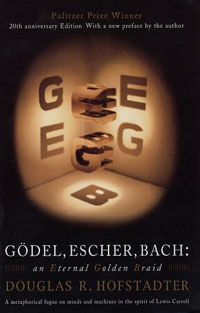This kind of solid was idealized by Douglas R. Hofstadter to illustrate the cover of his book Gödel, Escher, Bach: An Eternal Golden Braid.

|
SUPPLEMENTARY NOTES
|
| BACH, ESCHER E GÖDEL |
|
This kind of solid was idealized by Douglas R. Hofstadter to illustrate the cover of his book Gödel, Escher, Bach: An Eternal Golden Braid.
|
| EXPANDING THE IDEA: THE DIGITAL SUNDIAL | |||
|
Are there objects whose projections include more than 3 letters? The answer is yes!
In fact, there is a theorem from the fractal theory that guarantees the following:
if you choose a collection of plane pictures (not necessarily letters),
there is an object whose projections include the pictures you've specified (except
for a set of measure zero).
|
| THE CORK PLUG |
|
The object below has three holes in the form of a square, a circle and a triangle. The circle's diameter and the square's side have the same length. The triangle is isosceles and its base and height have lengths equal to the length of the square's side. Is it possible to build a three dimensional solid that can stopper tape these three holes? Click/touch on the image below to see an answer!
|